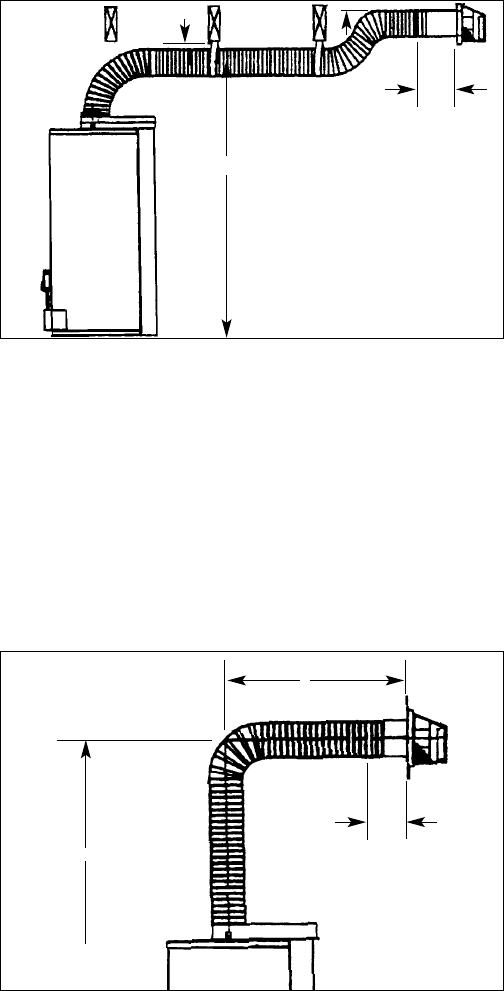
– 5 –
Inlet gas pressure to the appliance must not exceed the
gas pressures marked on the rating plate; 7” W.C. for
natural gas, 14” W.C. for L.P. gas. The minimum supply
pressure for the purpose of input adjustment is 1” above
manifold pressure.
The appliance and its individual shutoff valve must be
disconnected from the gas supply piping system during
any pressure testing of that system at test pressure in
excess of 1/2 psig (3.5 kPa).
The appliance must be isolated from the gas supply
piping system by closing its individual manual shutoff
valve during any pressure testing of the gas supply piping
system at test pressures equal to, or less than 1/2 psig
(3.5 kPa).
The appliance and its gas connection must be leak tested
before placing the appliance in operation. It is important
to have a readily accessible manual shutoff valve in the
gas line supplying the heat close to the heater. A drip leg
must be installed ahead of the gas control valve to help
trap sediment and foreign material.
A ground-joint union must be installed ahead of the gas
valve to permit easy removal of the unit. All leak testing
must be done with a soapy water solution.
NEVER USE A MATCH OR OPEN FLAME TO TEST FOR
GAS LEAKS. A FIRE OR EXPLOSION COULD RESULT.
WATER PIPING
Pipes and fittings should be installed in compliance with
the installation drawing. Check for dip tube in cold water
fitting before connection of hot and cold water lines. Show
where the water shut-off valve for the water heater is
installed so that the owner knows where and how to shut
the water off. It is recommended that such a valve be
located in close proximity to the cold water inlet of the
water heater.
Connect the cold water supply (3/4 NPT) to the fitting
marked “COLD”, the hot water outlet (3/4 NPT) to the
fitting marked “HOT”. Do not apply heat to either of these
fittings as they contain a nonmetallic tube. When making
these connections, always use a good grade of pipe joint
compound and be certain that all fittings are tight. See
installation drawing (FIGURE 2).
After piping has been installed, allow tank to fill with water
and check connections for leaks. To insure complete
filling of the tank, allow air to exit by opening the nearest
hot water faucet until a constant flow of water is obtained.
TEMPERATURE & PRESSURE RELIEF VALVE
For protection against excessive pressure and/or
temperatures, a temperature and pressure relief valve
has been installed in the water heater.
ANY REPLACEMENT VALVE MUST NOT EXCEED
THE TEMPERATURE AND PRESSURE RATING.
FAILURE TO INSTALL AND MAINTAIN A NEW,
PROPERLY LISTED TEMPERATURE AND PRESSURE
RELIEF VALVE WILL RELEASE THE
MANUFACTURER FROM ANY CLAIMS WHICH MIGHT
RESULT FROM EXCESSIVE TEMPERATURE OR
WATER PRESSURE.
GAS CONNECTIONS
Install the gas piping as indicated in Figure 2. Use only
new pipe and fittings with sound, clean-cut pipe threads.
Sealing compound must conform to the applicable code
for pipe sealing compound approved for use with natural
gas and propane. Use gas piping of adequate sizing to
ensure full gas input. All piping must comply with all local
codes. In the absence of local codes, piping must comply
with the rules stated by the applicable National Fuel Gas
Codes. The final connection to the gas control valve is
made using 1/2” N.P.T. pipe.
WALL
10”
(REF)
Figure 3 L - CONDITION 2
Where floor joists impede venting, a rise to complete the
vent termination is possible. All installations require 1”
clearance to combustibles.
Note:
A. The maximum horizontal vent pipe length of 90” minus
wall thickness should be considered when installing
an offset vent arrangement.
B. Do not Combine condition (3K) with condition (3L)
in the same installation.
High Rise Vent Pipe Arrangement
Figure 3 M
When the height H (From vent terminal center line to
bottom of heater) is over 90”, it is a high rise vent pipe
arrangement. The minimum distance “D” from the center
of the water heater to the outside wall surface is 22”, and
the maximum height of “H” is 12 feet.
68 MINIMUM
H
TO BOTTOM
OF HEATER
D
WALL THICKNESS
>1”
>1”
10”
(REF)















